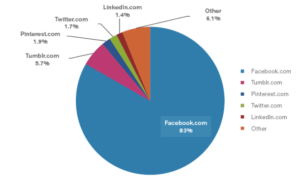Most people are pretty happy when they take a look at their web site traffic and see that a large...
3 social networks that brands should ignore
Social media has changed the way people interact by providing new ways and new venues for people to interact with a much larger sphere of friends, acquaintances, and associates. Billions of people interact on social: Facebook has more than 1 billion users, Twitter has 230-plus million monthly visitors, and Pinterest has more than 70 million users.
So why should a brand consider ignoring these audiences? It’s simple. Successful marketing requires more than just an audience. To be successful, you need to be talking to the right people, in the right place, at the right time, and with the right message. For the most part, from a marketer’s perspective, social platforms are a huge miss on being the right place, and they also can miss in the other respects as well.
According to comScore, Facebook is far and away the most used social network, accounting for 83 percent of time spent on social networking sites. But since I covered the marketing downsides of this platform a few months ago in my article “5 reasons your brand doesn’t need Facebook,” let’s take a look at some of the other popular social sites.
Source: comScore. As a quick side note, “time spent” isn’t necessarily the best metric to gauge a media outlet. For years we’ve compared internet consumption to TV consumption and suggested the internet should have an equal budget to TV simply based on time spent. But every medium has a different benefit and levels of engagement. Just because people spend more time watching TV doesn’t mean you should spend your dollars there if you can’t reach the right audience.
Followers are akin to “likes.” But does having a lot of followers mean you’ve found the right audience? Brands are enamored with gaining more followers, and followers are much easier to get than “friends” on Facebook. With Twitter, the personal connection is often much more distant than we see in other platforms. People follow people they don’t know and have never met. They have significantly less invested in the relationship. Although your Twitter network is likely comprised of an array of thought leaders, influencers, and celebrities, these people have a limited impact on your actions and decisions.
Twitter also tends to lack conversation. Topics are posted, some are retweeted, but many go unnoticed. People aren’t spending hours a day (or even a significant number of minutes per day) on Twitter. For most users, Twitter isn’t a key piece of their active social life. That said, Twitter can play an important role as a research tool for trends and information about a specific topic or interest area. (On Twitter, you can learn all you want about Justin Bieber, given his 47 million followers and 24,000 tweets.)
Twitter is also limited in its opportunity to pass on the right message. One of the key means to engage with prospects is through an emotional connection. For the most part, 140 characters doesn’t provide enough opportunity to truly inspire a prospective customer.
Now I’d be remiss if I didn’t talk about timeliness for Twitter. Most marketers know of the big “win” Oreo had tweeting during the Super Bowl when the power went out. It stood out, people noticed — but did it really help sell Oreos? After all, most people found out about the tweet through other media coverage — not by being on Twitter.
Pinterest is another social platform that’s getting a lot of attention today. The audience continues to grow, but page views are decreasing. While some of this might be due to mobile traffic, I believe more of it is shifting to category-specific sites that expand on the original concept of Pinterest, but provide a more specific user benefit. So again, here we’re looking at a challenge with finding the “right audience” on Pinterest.
For example, Houzz.com is a great site for looking at large images of decorating and product ideas for your home. It fits somewhere between a manufacturer’s product information site, a traditional interior design magazine type site, and an e-commerce site. So while Pinterest has a significantly larger audience, a site like Houzz provides a more interactive resource for an audience who’s more actively engaged.
One of the better-known uses of Pinterest is by prospective brides who build out extensive pin boards with everything they want to have at their wedding. While this might seem like an ideal marketing opportunity, one of the interesting trends is that many of these bridal pinboards are created by women who aren’t engaged — and sometimes aren’t even in a relationship. So while at face value these might seem to be an ideal audience, in reality, they might be a long way off from being in the active market.
As hard as it has tried over the years, LinkedIn is still primarily a business networking and job hunters site. Groups are growing, interaction is happening, but LinkedIn is still struggling to be considered an information source. There are too many vertical industry news and information sites in place that provide the functionality and social opportunities LinkedIn strives to provide. Again, we have a social network that provides a significant audience, but it isn’t integrated into users’ day-to-day business decision-making processes.
OK, so before I digress into the picture and video sharing, blog compilation, reviewer, and other social platforms marketers should ignore, the real point here is that social media platforms have audiences — but that doesn’t mean they’re a good place for marketing.
Is” ignore” too strong a word? Probably. As a marketer, you need to be aware of opportunities. But you also need to make sure you take into account all the elements required to be successful and evaluate how a platform can truly impact your brand.
No one wants to miss out on the next big thing. But on the flip side, do you really want to be the person who has to explain why your company spent so much on Second Life?




